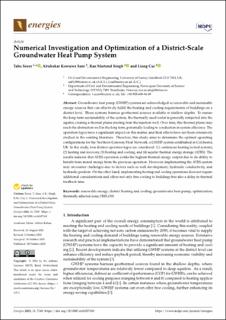| dc.description.abstract | Groundwater heat pump (GWHP) systems are acknowledged as renewable and sustainable energy sources that can effectively fulfill the heating and cooling requirements of buildings on a district level. These systems harness geothermal sources available at shallow depths. To ensure the long-term sustainability of the system, the thermally used water is generally reinjected into the aquifer, creating a thermal plume starting from the injection well. Over time, this thermal plume may reach the abstraction well in the long term, potentially leading to a reduction in system efficiency. The operation types have a significant impact on this matter, and their effects have not been extensively studied in the existing literature. Therefore, this study aims to determine the optimal operating configurations for the Northern Gateway Heat Network, a GWHP system established in Colchester, UK. In this study, four distinct operation types are considered: (1) continuous heating (actual system), (2) heating and recovery, (3) heating and cooling, and (4) aquifer thermal energy storage (ATES). The results indicate that ATES operation yields the highest thermal energy output due to its ability to benefit from stored energy from the previous operation. However, implementing the ATES system may encounter challenges due to factors such as well development, hydraulic conductivity, and hydraulic gradient. On the other hand, implementing heating and cooling operations does not require additional considerations and offers not only free cooling to buildings but also a delay in thermal feedback time. | en_US |

